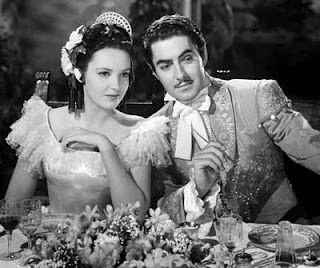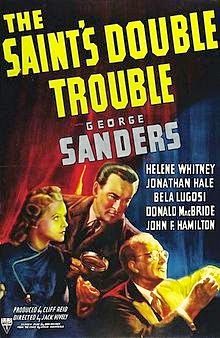Tonight's Movie: Bullets for O'Hara (1941)
Several years ago I watched an engaging Warner Bros. "B" movie, PUBLIC ENEMY'S WIFE (1936), which starred Pat O'Brien as a G man who weds the ex-wife (Margaret Lindsay) of a mobster (Cesar Romero) to lure him out of hiding. The marriage is meant to be temporary but you can guess how that turns out! The film wasn't always plausible but I found it a lot of fun.
The story was loosely remade just half a decade later as BULLETS FOR O'HARA (1941), which I watched this evening. This time around Roger Pryor is a detective rather than a G man, with Joan Perry as the mobster's ex and Anthony Quinn as the very jealous crook.
 Unfortunately the plot was even less believable in the remake, especially with the story shortened from 69 minutes all the way down to 50! I like a brisk movie, but that's really too short for much character or relationship development to take place; everyone's too busy running around from Point A to Point B.
Unfortunately the plot was even less believable in the remake, especially with the story shortened from 69 minutes all the way down to 50! I like a brisk movie, but that's really too short for much character or relationship development to take place; everyone's too busy running around from Point A to Point B.The movie's biggest drawback is that Pryor is unfortunately lacking in either looks or charisma, and he and Perry have no chemistry whatsoever; it also doesn't help matters that his character is caught completely off guard by Quinn's character on two different occasions! It makes him look more than a little foolish. Perry is a little more interesting as the disillusioned wife and then reluctant bride, and her character has a nice scene where she demonstrates her resourcefulness.
 Perry became Mrs. Harry Cohn the month this film was released and only appeared in a couple more movies after this. She was married to Cohn, the head of Columbia Pictures who was two decades her senior, until his passing in 1958. Perry lived until 1996. She and Cohn had four children, one of whom died in infancy. Perry was married to actor Laurence Harvey from 1968 to 1972, when they divorced. Joan is buried alongside her first husband Harry at Hollywood Forever Cemetery; a photo of the family plot is here.
Perry became Mrs. Harry Cohn the month this film was released and only appeared in a couple more movies after this. She was married to Cohn, the head of Columbia Pictures who was two decades her senior, until his passing in 1958. Perry lived until 1996. She and Cohn had four children, one of whom died in infancy. Perry was married to actor Laurence Harvey from 1968 to 1972, when they divorced. Joan is buried alongside her first husband Harry at Hollywood Forever Cemetery; a photo of the family plot is here.Quinn is fine in the role originally played by Cesar Romero; whatever energy the film has largely comes from his performance.
Fans of character actor Frank Ferguson -- and there are many -- will enjoy spotting him as a prosecutor in one of his very first films. His screen career began the previous year, in 1940; he would eventually have over 300 credits in a career which lasted over three dozen years. One of his very last parts was in THE MACAHANS (1976), which I recently wrote about after seeing it at the Lone Pine Film Festival.
 The supporting cast of BULLETS FOR O'HARA also includes Maris Wrixon, Dick Purcell, William Hopper, Joan Winfield, Milton Kibbee, and Joe King. The film was directed by William K. Howard and shot by Ted McCord.
The supporting cast of BULLETS FOR O'HARA also includes Maris Wrixon, Dick Purcell, William Hopper, Joan Winfield, Milton Kibbee, and Joe King. The film was directed by William K. Howard and shot by Ted McCord.BULLETS FOR O'HARA is not on DVD or VHS. It's shown from time to time on Turner Classic Movies.
The trailer can be seen on the TCM website.


















































